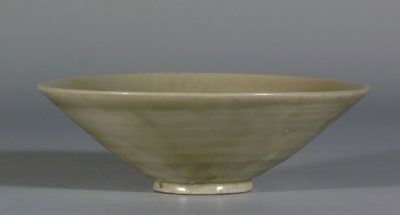Celadon Bowl (Dongyao type)
- H 4.8㎝ MD 14.4㎝ BD 4.4㎝
- Five Dynasties -Northern Song Dynasty, 10-11th century
This bowl is a similar item to the bowls that Koyama and Hasebe considered to be Dongyao type, but a little bit different from the other two Dongyao type works in Tokiwayama Bunko Collection. Although similarly thinly made, the rim is little thick, and the glaze tone is greyish rather than bluish such as two others. While this bowl has similar features to Dongyao type bowls in shape, size, clay and some of foot characteristics, different cutting way is found on this bowl’s foot.
“Dongyao” is the kiln name seen written in ancient texts. During the time when archaeological excavation had not yet developed and production kiln sites had not been identified for extant works such as Ru ware or Yaozhou ware, Fujio Koyama wanted to find “Northern Song imperial ware” and tried to make clear in terms of the Dongyao concept. Among the works of the Yaozhou kiln group that were called “Norhtern Celadon” at the time, he selected works with whitish tone glaze and he posited them the name “Dongyao” mentioned in ancient texts. He then connected those Dongyao works with Northern Song imperial wares.
Subsequently, as archaeological excavations progressed, specific works from the Ru kiln and the Yaozhou kiln were revealed on after another, and the celadon that Koyama distinguished as “Dongyao” came to be incorporated into Yaozhou kiln. In the trend of trying to solve all of northern celadon in the development of Yaozhou kiln, Gakuji Hasebe succeeding Koyama’s study of the subject, once again picked up the celadon bowls that Koyama once described as “Dongyao” and similar items that had common features in the shape, size and pale whitish glaze tone, and then he differentiated them from Yaozhou wares. In 2006, at the symposium on Ru kiln held at National Palace Museum, Taipei, Hasebe pointed out that it is difficult to grasp the appearance of Ru ware celadon in the context of the development of Yaozhou ware. During the Northern Song period, he advocated the possibility of wide-ranging celadon production in the North.
As for the kiln that fired celadon in the north from the Five Dynasties to the Northern Song Dynasty, only the Yaozhou kiln has been reported at this time. The archaeological report indicated that only a few examples of the Dongyao type bowls have been found at the Huangpu kiln site that the Institute of Archaeology, Shaanxi province and the Yaozhou Museum considered to be the Five Dynasties Yaozhou kilns, and that this bowl type was then not continued at the Yaozhou kiln site considered to be the Northern Song Yaozhou kiln. On the other hand, reference with the reports of excavated works from datable tombs indicates that a group of bowls – here called “Dongyao type” and all sharing common size, shape, clay, glaze tone and foot characters – existed from the end of 10th century through the first quarter of the 11th century.
While it is possible that Dongyao type bowls were produced at the Yaozhou kiln, given the rarity of their discovery at the Yaozhou kiln site, we might consider instead that Dongyao type bowls were produced in other northern Chinese kilns. Here we propose that celadons were produced at several northern Chinese kiln, each with their own aesthetics, and one of these kilns developed wares that in time became the late Northern Song Ru ware. This undecorated whitish tone celadon bowl might form a critical tool in the essential study of pre-Ru ware celadon production in northern China.
Publications
*The Bulletin of the Chinese Ceramic Study Association of Tokiwayama Bunko Foundation vol.5 ”Dongyao”Celadon, Tokiwayama Bunko Foundation, 2013 (see commentary by Sarah Sato)
*Selected Masterpices from the Tresures of Tokiwayama Bunko Foundation, commemorating the 80th Anniversary of Tokiwayama Bunko Foundation, Tokiwayama Bunko Foundation, 2023 (see commentary by Keiko Mikasa)






